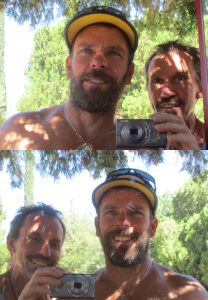The biggest reason for having a true mirror in your life is to learn about who you are and how you are using this new visual medium that accurately reflects your face. We are incredibly expressive beings, with hundreds of nuanced expressions that are fairly easily read by others. How does this happen? Well, we use a “map” to read people’s expressions, and through experience we learned how to match someone’s expression to what they were saying. Not that we are always right, but generally, there is pretty close correspondence between what a person is saying and our interpretation of their facial expressions.
We also understand deeply through this information highway when we talk to each other. Within milliseconds we can interpret and respond to what another is saying, using both words and expressions. Whatever we say face to face, it always uses this same map, where the right side of the expression is on the right side, the left side of the expression is on the left side. I believe that those sides say distinctly different messages, most notably during vibrant expressions such as the genuine smile.
Our genuine smile is a major communication tool. We only flash it when we are feeling it…else it will not appear genuine. When someone sees it, and understands why it is there, the amount of communication is immense. And almost always a genuine smile will be met with another smile…it’s how we work. It’s probably related to mirror (pun unavoidable) neurons, similar to how we yawn when we see another yawning. We generally smile when we see people smiling.
My opinion is that the traditional mirror, aka mirror-mirror, regular mirror, backwards mirror, flat mirror, and so on, significantly scrambles the information that is flowing to our own eyes. There is so much nuance in a smile that makes it genuine, created with all sorts of micro-expressions plus the “why” of the smile, that when you flip it left to right, that nuance is completely altered. That same mirror neuron communication that works so well with others has a completely different setup when you gaze into your flipped eyes. My experience with thousands of people has shown that the setup just doesn’t work: within seconds almost every single person’s genuine smile is lost and they never see it. And by correlation, any other genuine expression is likewise altered. Over a lifetime? Who do we think we are – the real person, or what we see in a mirror?
The amazing thing about a true mirror is that it gets it right. Making eye contact with oneself in this unaltered way allows all those mirror neurons to fire normally, and the map used to interpret everyone else’s face also matches for what is in your face, and so your communication flow continues accurately. Its astonishing to watch when people see themselves this way.
So can the true mirror be used as a tool to gain insight into our real selves and how we are doing? Absolutely. Just as we can meet up with a close friend and tell them what is going on, we can likewise meet with ourselves in the true mirror. Not just seeing the surface feelings, but deeper, with the nuances that reflect continuously what is there. And, just as a close friend will see deeper truths about us, likewise we can with ourselves.
To get there however you have to show up. Staring without expression doesn’t do it, you have to be yourself to see yourself.
Below are the first draft of exercises to be done in front of the true mirror, designed to train you how to look beyond staring at yourself and to ask and answer questions of yourself. These will be fine tuned and included with the future shipments of True Mirrors.
- Look in a true mirror with a friend – stand side by side and make eye contact in the mirror. Look for their smile, then look back at your own eyes smiling. Having a friend helps a lot to bring us out of the mirror pattern.
- Look when you are deeply emotional about something – what do you say to yourself about how are you feeling. Stay long enough for a full sharing of whats going on with you. This applies for both sad and happy events, and demonstrates the value being able to stay in your emotion continuously without it being altered as you watch.
- Say hello to yourself, even for a split-second, in a true mirror whenever you pass it. Notice the difference when you do the same in the mirror-mirror.
- Meditate with your eyes closed for a good amount of time, then open them up to look in the true mirror. Look and feel how your calmed state is reflected in your eyes.
- Avoid making eye contact with regular mirrors for a month, only look in true mirrors. Then, try to look in the mirror and see how you feel. Notice the quality of your expression and examine your takeaway.
- Practice affirmations that will show on your face. “I am …” works well. Affirm the future state of who you want to be and notice how you can make it appear in your eyes right Now in the moment. Practice “as I believe, so I see” to help validate your process.
- Think about what you are projecting to others now that you have a more accurate sense of what that looks like. Work on synchronizing what you believe you are to what you are actually projecting, notice where the true mirror helps.
- Write in a journal about what you are seeing, and repeat regularly. Notice how your perception shifts; work towards making it more authentic to what is really there.
That’s a few, if you have more, let me know!
JWalter 4/19


Recent Comments